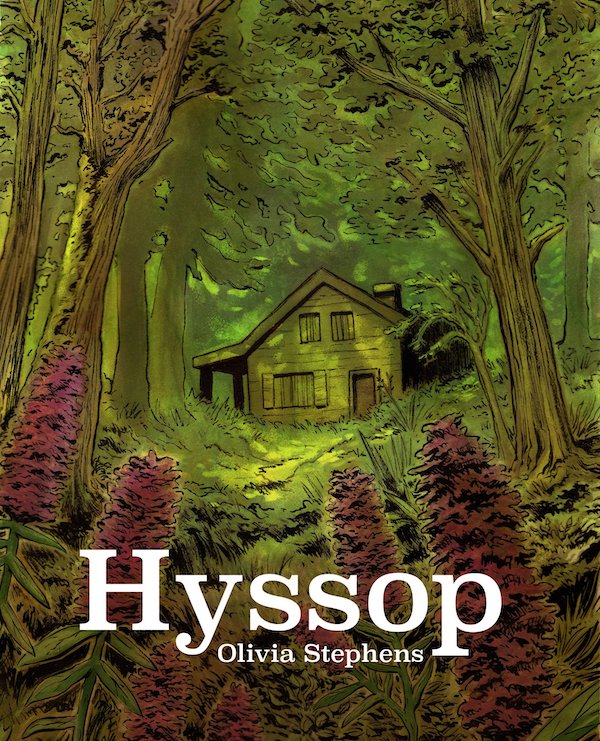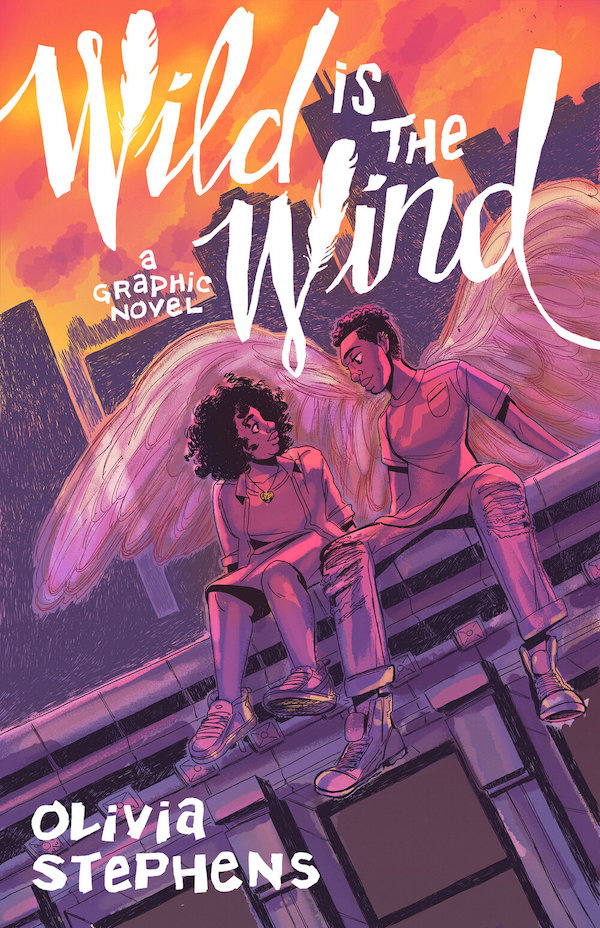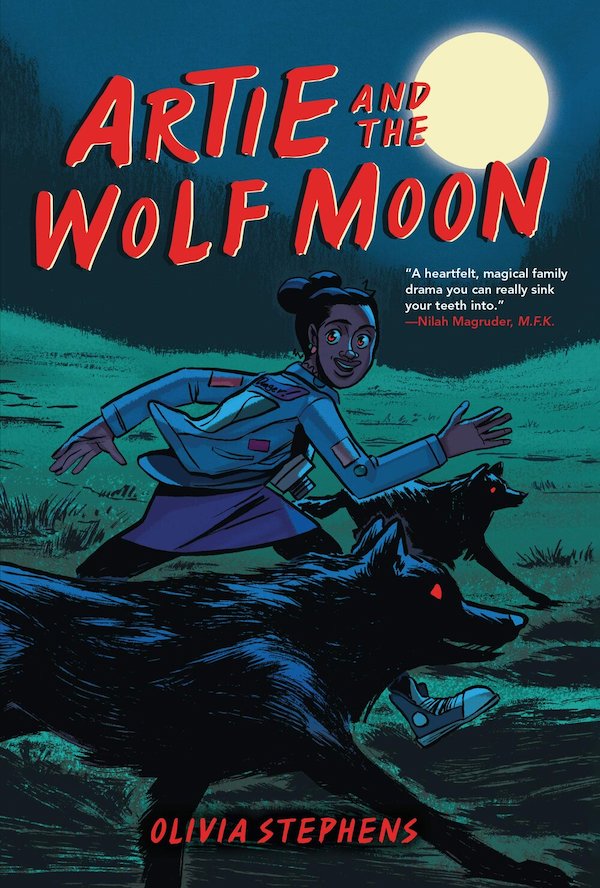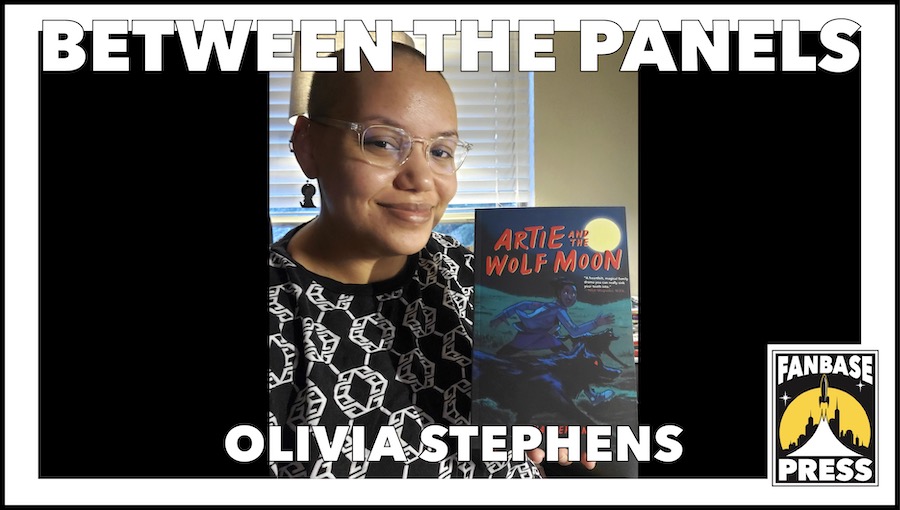“Between the Panels” is a bi-weekly interview series focusing on comic book creators of all experience levels, seeking to examine not just what each individual creates, but how they go about creating it.
By Olivia Stephens’ own admission, making stories for a middle grade audience was something that she had never considered before the delightful graphic novel, Artie and the Wolf Moon, in 2021. But that book is just one step on a journey that’s taken Olivia from telling visual stories as a little kid to Rhode Island School of Design to the wide world of webcomics.
First off, the basics…
Your specialties (artist/writer/letterer/inker/etc.): Writer/Artist
Your home base: Washington State
Website: olivia-stephens.com
Social Media
Twitter: @OliveOilCorp
Instagram: @OliveOilCorp
Tumblr: Oliveoilcorp
Patreon: Oliveoilcorp
Fanbase Press Contributor Kevin Sharp: I always start with the big question: Why comics? As someone who’s worked in this medium both traditionally and digitally, what attracts you to it as an artform?
Olivia Stephens: Comics is the medium where I feel like I can say everything that I need to say. When I was growing up, I tried to write prose novels. But I always found myself getting stuck. There were always points in the story where I’d stop and think, “I need a picture to show this part better.” Some things I can only say with words, and some I can only communicate with pictures. Comics combine both into a wholly unique language that lets me say everything that I need to say.
KS: Please tell readers a little about where you grew up and what types of media you consumed as a kid. Books, shows, movies, whatever else…
OS: I grew up in Washington State, a bit south of Seattle. I’ve always been an avid reader of fiction and nonfiction. I remember loving this big book of fairytales for all of its illustrations. I also had a soft spot for Lemony Snicket’s Series of Unfortunate Events. I read a lot of books about Black history, like Ann Petry’s Harriet Tubman: Conductor on the Underground Railroad. I loved supernatural fantasy in any form. Like a lot of kids, I held a deep interest in animals and the natural world. Animal Planet definitely helped raise me.
KS: When did comics enter the picture for you? Did you have easy access to them, either through a library, LCS, friends, or whatever else?
OS: I read some Captain Underpants books in elementary school, but it wasn’t until middle school that I really fell in love with comics through manga. I’d sit on the floor of Borders and read volumes together with my friends. I also read a ton of manga fan translations online and checked out random series available in the school library. My love of manga expanded to a lot of independent webcomics.
KS: Did webcomics appeal to you in a different way than manga?
OS: Something about the DIY nature of independent webcomics invigorated me. These comics shifted the way I view narrative freedom. Webcomics got to be weirder than anything I’d read in a traditionally published book. I wanted to make my own weird stuff.

KS: At Fanbase Press, our #StoriesMatter initiative endeavors to highlight the impact that stories can have on audiences of various mediums and about the way a reader can find an important story at just the right time. What was a particular comic book story that had an impact on you in your younger years?
OS: Bleach! That series changed my life. I discovered Tite Kubo when I was 11 or 12 years old, and his work made me want to draw in a serious capacity. I remember doing master studies from Bleach and Zombie Powder before I even knew what master studies were. There’s this undeniable coolness to Kubo’s work that appealed to me. I wanted to draw things that were cool like Bleach. You can’t beat the adrenaline rush of your first introduction to Shonen manga.
KS: To flip from you as a fan to you as a creator, what did your creative life look in childhood? Was there a particular medium you were drawn to (No pun intended.) more than others (e.g., writing, drawing, painting, etc.)?
OS: I’ve always been drawn to telling stories with words and illustrations. One of my favorite activities in class during elementary school was “writing workshop” time, where we got to write, edit, and illustrate little picture books. I remember writing this long, drawn-out series starring a family of mice. I had probably been reading Redwall or something at the time and ran away with it.
KS: How about your earliest tries at what we’d identify as the comics form?
OS: I think my earliest comics experiment was when I was around 6 or 7 years old. I had read a lot of Captain Underpants and decided that I needed to make my own comic book called Captain Bikini. I stapled a bunch of copy paper together and filled them in with illustrated panels. It probably didn’t make any sense, but I had a lot of fun sitting on the floor of my grandmother’s house and drawing it with markers.
KS: When did the idea of a comics as a career pursuit arrive for you, the notion that you might be able to parlay your hobby into something sustainable?
OS: It was around the beginning of high school that I started to consider comics as a career. I credit the independent cartoonists whose webcomics I followed at that time. It wasn’t until later that I ever thought of venturing into traditional book publishing, but independent webcomics made me feel like I could forge my own professional path outside of gatekeepers.
KS: Which creators were you following at the time who inspired you?
OS: I adored — and still very much adore — the work of folks like Blue Delliquanti, E.K. Weaver, Mildred Louis, and Der-shing Helmer.

KS: Did you have a vision for what that career might look like, either in your general daydreams or in comparison with someone you admired who had already “made it?”
OS: I was deeply excited by the idea of being an independent creator in webcomics. In my eyes, people who “made it” had a bunch of online readers, ran successful crowdfunding campaigns for printing their webcomics, and just generally made their own creative corner of the internet.
KS: Because many of our readers are aspiring creators, please talk about what concrete steps you took initially — when you were an unknown — to get your work into the world, in front of the right people.
OS: I think the most impactful thing I did for my career was starting and updating a long-form webcomic during my time in art school. It was difficult finding the free time to work on my own comic project outside of class assignments and campus jobs, but my webcomic is what initially grabbed the attention of editors from traditional publishers. It was vital to have that evolving showcase of personal work that I was invested in. People can tell when you really care about the work you’re sharing.
KS: Let’s talk about that art school time. First, how did you decide on RISD? Were there others you were considering?
OS: Almost all of the colleges I applied to were liberal arts colleges, not art schools. I figured that if I was going to take a gamble on art school, I would try getting into one of the best. I was fairly naive about my options, so the reputation of RISD as a top art school definitely influenced my decision. I probably wouldn’t have earned a BFA at all if I hadn’t been accepted there.
KS: Can you look back now and pinpoint something different about the artist who enrolled versus the artist who graduated?
OS: The biggest difference between those two versions of myself is that I learned discipline. Specifically, the discipline required to see a creative project through to completion. Finishing is a critical skill to learn for anyone who wants to tell stories.

KS: Perfect segue to Artie and the Wolf Moon. I won’t ask the dreaded “where do you get your ideas” question, but rather in this case which came first: the story or the audience? In other words, was this a story you had in mind, or did you specifically want to create a book for a middle grade readership and came to the story from there?
OS: In the latter half of college, I was contacted by a graphic novel editor who had read and enjoyed my romance webcomic Alone, and who wanted to see if I had any graphic novel pitches for young readers. I had never seriously considered writing for that audience before, but I wanted to challenge myself to make a pitch. So, I combined story elements that excited me when I was younger, like cool supernatural powers and family secrets — and werewolves. That pitch became Artie and the Wolf Moon.
KS: As someone who enjoyed the words/pictures combination for so long, did you find your way in the through plot or images first? What were your initial author steps in laying out your book?
OS: The plot usually finds me first, or at least the premise of a story. I try to build the art around the story and not the other way around. I write a full outline before I think too much about what the characters look like. In the case of Artie, making the character designs early was necessary for pitching to publishers. But it’s not how I work naturally. I can’t think visually until I have all of my words put together. I’ll write the script first, based on my outline, and then dive into thumbnails and sketching out the book.
KS: Can you shout out a person who was especially helpful to you somewhere along this creative journey? Maybe they offered support at a key time, gave advice, opened a door for you, made an introduction…
OS: Mel Gillman. They have basically been there for me since I was a baby cartoonist unsuccessfully applying to comics anthologies. I have come to them for advice and support on countless occasions, and they have never hesitated to hype me up. It’s still surreal to me that someone I started out admiring from the distance as a fan is now someone I call a friend. I’m incredibly grateful to have Mel in my life. Thank you, Mel!
KS: What would have been an acceptable Plan B career if the arts never worked out? Something where you imagine you could have at least been content doing day to day.
OS: I’ve actually been looking into alternative career paths, if only to toy with the idea of placing some distance between my love of making art and my means of income. It can be quite mentally taxing when those two things intertwine! So, I’ve been studying data analysis recently, and I find it fascinating. It activates my curiosity about the root causes of human behavior in a similar way that storytelling does.
KS: To wrap up, can you give us a comic or graphic novel you’d hold up as an example of the medium at its very best?
OS: Fullmetal Alchemist by Hiromu Arakawa. It’s the closest thing to a perfectly crafted narrative that I can think of. Reading it as an adolescent, Arakawa’s handling of “equivalent exchange” as a concept had a deep impact on my views toward nature and the world.

KS: And finally, please let readers know what you have out now and what you have coming up that they can be on the lookout for.
OS: I recently self-published Darlin’ and her Other Names Part 1: Marta, the first installment of a werewolf-western-horror-romance comic that has been my pet project for a couple years. It’s an adult take on werewolves that ruminates on tenderness, solidarity, and the brutal history of wolf extermination campaigns in the United States. Folks can support future installments of the project and get behind-the-scenes peeks on its progress on my Patreon. And I can’t go into specifics yet, but I’ll have another new horror comic out sometime in the fall.

